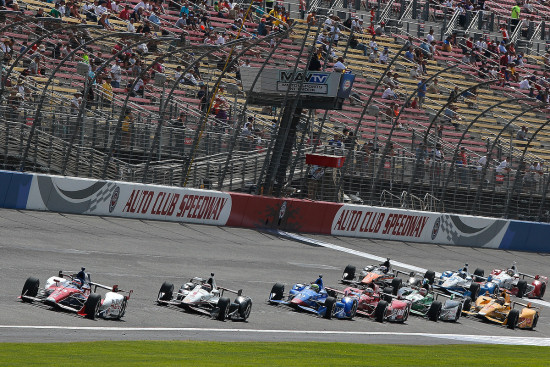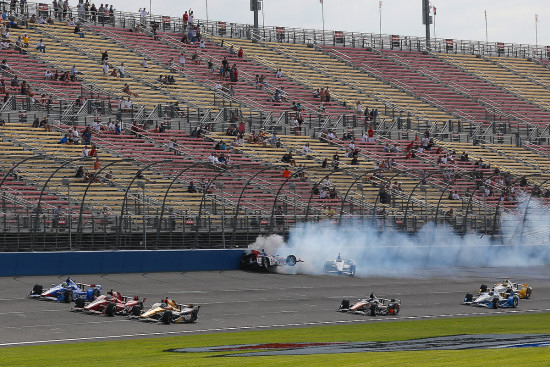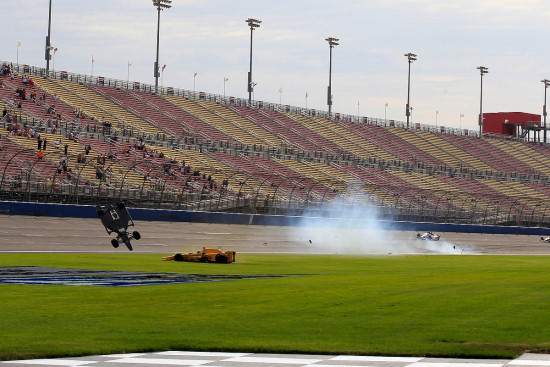The Way It Is/ IndyCar's lack of continuity or stabilityby Gordon Kirby |
 In recent years I've discussed the errors of IndyCar's pack racing rules at considerable length in this space. Every great driver I know has pleaded for a change in direction to more power and less downforce yet nobody in IndyCar has listened or responded. We saw more of the errors of IndyCar's ways at the California Speedway last Saturday with plenty of close but scary 'pack' racing and crashed cars. Fortunately no one was hurt and Juan Pablo Montoya, Will Power and Tim Cindric made their displeasure with the rules very clear on TV after the race.
In recent years I've discussed the errors of IndyCar's pack racing rules at considerable length in this space. Every great driver I know has pleaded for a change in direction to more power and less downforce yet nobody in IndyCar has listened or responded. We saw more of the errors of IndyCar's ways at the California Speedway last Saturday with plenty of close but scary 'pack' racing and crashed cars. Fortunately no one was hurt and Juan Pablo Montoya, Will Power and Tim Cindric made their displeasure with the rules very clear on TV after the race.
Rather than bang on yet again about going to more power and less downforce I'm going to discuss another component in IndyCar's deep web of problems this week which is its incredibly weak, unstable and haphazard schedule. IndyCar has backed itself into this messy calendar without any plan or leadership, other than struggles for power which have resulted in the destruction of no fewer than 42 CART, Champ Car, IRL or IndyCar races over the past 15 years. This factoid captures Indy car racing's essential failure which is the complete absence of continuity or stability to the schedule and the consequent destruction of its fan and media base in numerous local markets. The only IndyCar races currently enjoying established longterm dates are the Indy 500, Long Beach and Mid-Ohio. The rest of the meager schedule of sixteen races have been moved around, recently added to the calendar, or reinvented in some way with no sense of tradition, stability or date equity.  © LAT USA The season-opener in St. Petersburg started life as a CART race in 2003 and draws a respectably small crowd, around 20,000. This year's first race at NOLA was a disaster. It's a track IndyCar shouldn't be running at but is compelled to because there are no other takers. Long Beach started in 1975 as a Formula 5000 race, then an F1 race from 1976-'83. CART's first race at Long Beach came in 1984 and through the race's heydays in the late eighties and nineties it used to attract more than 90,000 people on race day and more than 220,000 over the weekend. These days Long Beach hangs in there, drawing around 40,000 people on race day. One of the brighter spots on IndyCar's schedule is Barber Motorsports Park in Alabama which has been on the calendar since 2010. It's a beautiful little road course with a superb museum and draws a nice crowd, around 30,000. Last year the IMS debuted its road course IndyCar race--the Grand Prix of Indianapolis. A reasonable number of fans turned out for the first race but this year's second edition drew a very disappointing crowd. The Indy 500 itself hangs in there on race day, if not for qualifying, but there are plenty of empty seats these days in the front row seats along the frontstretch while a bunch of seats have been removed from turn three. Belle Isle in Detroit started as a CART race in 1992 and ran for ten years through 2001. It was revived as an IRL race in 2007 and '08 and revived again by Roger Penske in 2012. Penske has put a lot of money and effort into the place but the race struggles to draw much of a crowd and is primarily a corporate entertainment event.  © LAT USA Toronto started as a CART race in 1986 and was a great event for many years but today it's a sad shadow of its former self, drawing fewer than 10,000 people on raceday this year. The California 500 at what is now known as the Auto Club Speedway was a CART race from 1997-2002 before switching to the IRL for three years. The race died in 2006 but was revived by IndyCar in 2012. The date has moved every year since then and attendance has been miserable in recent years. It's hard to believe that almost 100,000 fans jammed the place for a few races at the track fifteen years ago. Last Saturday's 500-mile race saw a close battle all the way. Everyone likes to talk about how fiercely competitive Indy car racing is these days yet it's been proven time and again that IndyCar's version of NASCAR restrictor plate racing has little appeal to most race fans, witness the swaths of empty seats at Fontana in recent years. Next on IndyCar's schedule is Milwaukee which has a great history of Indy car racing. For many years the place was packed on race day but Milwaukee has struggled over the past dozen years, promoting both Champ Car and IRL races for a few years before running out of gas in 2010. Michael Andretti's sports marketing group took over the race in 2011 and is trying hard to make something happen at the historic venue. The Iowa Speedway ran its first IRL race in 2007 and has established itself as a nice, little race drawing 20,000 or so fans. Mid-Ohio ran its first Indy car race back in 1980 and ran a CART race for twenty-one years from 1983-'03. The track went without an Indy car race for three years before running its first IRL race in 2007. These days the race is supported by Honda and draws a reasonable crowd if nothing like its CART heydays. Pocono ran a 500-mile from 1971 under USAC sanction through 1989 with CART but the track became too bumpy and dangerous for Indy cars and was dropped from CART's schedule in 1990. Rebuilt and much improved some years ago Pocono revived its open-wheel race with IndyCar in 2013, running on July 4th weekend. But the track has struggled to draw much of a crowd and is experimenting this year with a late August date.  © LAT USA This brief survey makes it clear there are few stable or healthy races on IndyCar's schedule but the immense depth of American open wheel racing's many failures can only be fully appreciated by casting an eye down the stunning list of 42 CART, Champ Car, IRL or IndyCar races which have been lost over the past fifteen years. No fewer than 21 oval tracks have given up on Indy car racing during this time. They are: Michigan, Phoenix, Gateway, Chicago, Nazareth, Las Vegas, Rockingham (UK), Lausitzring, Rio de Janeiro, Disneyworld, Pikes Peak Speedway, Charlotte, Atlanta, Dover, Richmond, Nashville, Kentucky, Chicagoland, New Hampshire, Homestead and Motegi. Eleven temporary or street circuits have failed: Denver (twice), Vancouver, San Jose, Surfers Paradise, Houston (three times), Las Vegas, Miami, Cleveland, Edmonton, Baltimore and Sao Paulo. And ten permanent road courses gave up the ghost: Laguna Seca, Elkhart Lake, Portland, Montreal, Mexico City, Monterrey, St. Jovite, Zolder, Assen and Watkins Glen. It's also worth noting that Indy car racing's furtive attempts over many decades to expand internationally have also been an abject failure. Since the first of two Races of Two Worlds at Monza in 1957 no less than 30 international races have been tried by USAC, CART, Champ Car, IRL or IndyCar, and Toronto is the only one that survives! At its height fifteen and sixteen years ago CART had five or six international races but those days are long gone and unlikely ever to return. All this represents a truly remarkable record of instability and an utter lack of continuity. If IndyCar is to have any hope of reviving itself as a respected, well-attended, avidly-watched sport it must not only find a much better technical formula but also build much more stability and continuity into its schedule. And that's as tall an order as any of the many challenges facing the beleaguered folks on Sixteenth St. in Indianapolis. |
|
Auto Racing ~ Gordon Kirby
Copyright ~ All Rights Reserved |
